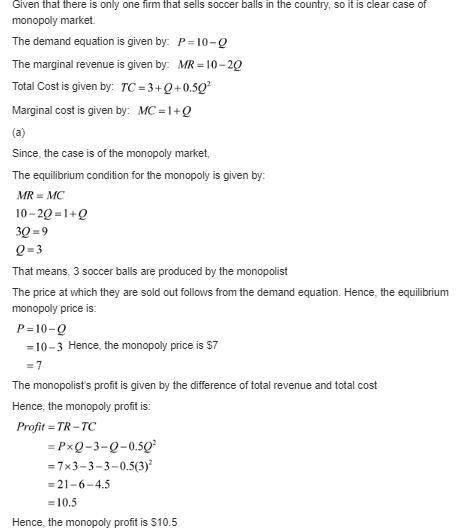
Business, 06.12.2019 22:31 liyahheadhigh
Only one firm produces and sells soccer balls in the country of wiknam, and as the story begins, international trade in soccer balls is prohibited. the following equations describe the monopolist’s demand, marginal revenue, total cost, and marginal cost:
demand: p = 10 – q
marginal revenue: mr = 10 – 2q
total cost: tc = 3 + q + 0.5 q^2
marginal cost: mc = 1 + q
where q is quantity and p is the price measured in wiknamian dollars.
a. how many soccer balls does the monopolist produce? at what price are they sold? what is the monopolist’s profit?
b. one day, the king of wiknam decrees that henceforth there will be free trade—either imports or exports— of soccer balls at the world price of $6. the firm is now a price taker. what happens to domestic production of soccer balls? to domestic consumption? does wiknam export or import soccer balls?
c. in our analysis of international trade in chapter 9, a country becomes an exporter when the price without trade is below the world price and an importer when the price without trade is above the world price. does that conclusion hold in your answers to parts (a) and (b)? explain.
d. suppose that the world price was not $6 but, instead, happened to be exactly the same as the domestic price without trade as determined in part (a). would anything have changed when trade was permitted? explain.

Answers: 2
Another question on Business


Business, 22.06.2019 15:20
Sauer food company has decided to buy a new computer system with an expected life of three years. the cost is $440,000. the company can borrow $440,000 for three years at 14 percent annual interest or for one year at 12 percent annual interest. assume interest is paid in full at the end of each year. a. how much would sauer food company save in interest over the three-year life of the computer system if the one-year loan is utilized and the loan is rolled over (reborrowed) each year at the same 12 percent rate? compare this to the 14 percent three-year loan.
Answers: 3

Business, 22.06.2019 19:00
All of the following led to the collapse of the soviet economy except a. a lack of worker incentives. c. inadequate supply of consumer goods. b. a reliance on production quotas. d. the introduction of a market economy.
Answers: 1

Business, 22.06.2019 22:30
The answer here, x=7, is not in the interval that you selected in the previous part. what is wrong with the work shown above?
Answers: 1
You know the right answer?
Only one firm produces and sells soccer balls in the country of wiknam, and as the story begins, int...
Questions













Mathematics, 12.08.2020 07:01

Mathematics, 12.08.2020 07:01


Physics, 12.08.2020 07:01

Social Studies, 12.08.2020 07:01

Biology, 12.08.2020 07:01

Chemistry, 12.08.2020 07:01





